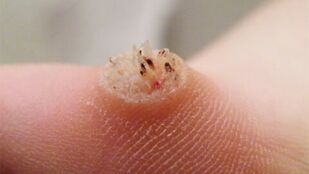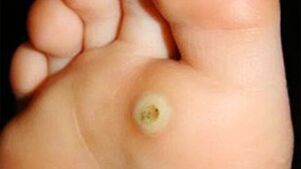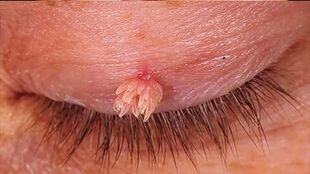
Warts are benign tumors of little aesthetic that appear on the skin infected with human papillomavirus. Entering the upper layers of the epidermis, the virus provokes the proliferation of its cells, resulting in the appearance of warts of various shapes, sizes and colors.
The human papillomavirus infects about 80% of people on the planet, and not all patients are aware of its diagnosis, as HPV is asymptomatic in most cases.
Wart Types
There are different types of warts depending on the location, color, size, shape and type of pathogen in the body.
Common or vulgar warts
Most common, their appearance does not depend on the patient's age or gender. They are located on the hands, between the fingers, at the back of the palm (rarely on the palm itself). Vulgar warts are irregular or round in shape, usually not very noticeable on the skin due to their flesh-pink color. The size varies from 1 to 3 mm, with prolonged infection and lack of treatment, groups of neoplasms may appear in the affected area.
Flat warts
Tumors of this species are more common in children and adolescents, so their second name is juvenile warts. Fleshy or light brown, oval or round lumps, with a smooth surface, rising slightly above the skin. It is mostly localized on the skin of the face, neck, arms and upper body.

plantar warts
This type of wart only appears on the skin of the foot, hence its name. Coarse growth with a layer of keratinized skin or a group of such growths. The skin around the plantar warts loses its natural color and turns grayish-yellow. The surface of the wart will become hard and begin to press on the healthy tissues around it, causing severe discomfort.
Dependent warts
This species is characterized by a narrow articulation with the surface of the skin, the presence of so-called “legs”. Suspended warts can be elongated, round or irregular, pink or reddish. Such warts are localized on women’s necks, faces, armpits, under the breasts. Often, the appearance of a number of dependent warts indicates a sudden decrease in the body’s immune status.
senile warts
These types of warts are more likely to affect the skin of older people. They are also called seborrheic warts or keratomas. They develop from age-related cells in the epidermis due to age-related changes and deterioration of metabolism, often grabbing the upper part of the hair follicles. Keratoms are round in shape, well demarcated, located on the scalp or face. The size ranges from a few millimeters to 4-5 cm.

Genital Warts
Genital warts or condylomas are the most unpleasant and painful types of cancer. It is caused by human papillomavirus types 6 and 11. Genital warts affect the skin adjacent to the mucous membranes: the lips and eyelids; genital area of the urethra, anus.
Genital warts often resemble cauliflower or cockscomb in structure. Condylomas are attached to the surface of the skin using a thin "foot". Due to localization in areas of the body prone to mechanical irritation, genital warts and adjacent tissues are associated with a high degree of injury, with infection and an inflammatory process developing with the formation of exudative or purulent secretions.
Causes of Warts
Increased activity of the human papillomavirus causes warts to appear in the body. Infection occurs during contact and daily life: by touch, handshake, common objects, and in public places if personal hygiene is not observed. Genital warts are sexually transmitted.
A virus enters its active form when there are factors such as:
- severe or chronic stress;
- transmitted infectious diseases;
- decreased immunity;
- hormonal disorders, improper metabolism;
- excessive sweating;
- skin trauma and microtrauma;
- Wears clothes and shoes made of unnatural materials.
If the disease is asymptomatic, it can only be diagnosed in the laboratory.
Warts in adults
Papillomas or warts can appear at any age. In this case, gender has no particular role to play - both men and women are prone to HPV. However, the risk of developing warts is higher in women, as their immunity is often weakened due to hormonal levels, pregnancy, and feeding the children. Due to the peculiarities of the anatomical structure, women are also more prone to the appearance of genital warts, especially genital warts, which increase the risk of developing cervical cancer.
In men, warts only occur when there is a sudden drop in immunity, which is less common in the stronger sex. However, men extremely rarely carry HPV types 16 and 18, which provoke the development of oncological diseases.
Warts in children
Warts are common in children and adolescents because their immunity is not fully developed, making them easily infected with papillomaviruses. An important factor is the fact that children attending kindergartens and schools are generally in an increased state of stress, which negatively affects the body’s defenses. In addition to the method of contact household infection, intrauterine infection of the mother is also possible.
Most commonly, children develop vulgar, juvenile, or plantar warts, while juvenile warts resolve on their own by the age of 14-18.

Wart Treatment
When treating warts, it should be understood that it is impossible to completely remove the pathogen from the body - the human papillomavirus. Once in the body, it stays in it forever, but healthy immunity is able to control and minimize the manifestations of its vital activity.
The appearance of warts indicates a decrease in the body's immune status, so measures to strengthen the immune system should be included in HPV therapy. With a reduced defense response from the body, even with successful removal of the warts, there is a high chance of relapse. However, in people with strong immunity, the warts can go away on their own.
Therapy should be selected by a competent physician after a thorough examination. Self-healing is unacceptable because a layman will not be able to distinguish a wart from a malignancy. The issue of removing thewartis also decided by a professional - the damaged tumor can degenerate from benign to malignant.
The following methods are available to eliminate warts.
- Cryodestruction (freezing with liquid nitrogen). This method is especially effective for common warts. The neoplasm is exposed to liquid nitrogen for 10-30 seconds. This method is good for low trauma; It takes 1-5 times to completely remove the wart.
- Laser coagulation (laser removal). The neoplasm is partially removed under local anesthesia. A groove remains at the site of the wart, which disappears after about a month.
- Electrocoagulation (current removal). The wart is removed with a thin metal loop using a high frequency current. This method is characterized by the absence of bleeding and further tissue disinfection. The tissues of the neoplasm remain intact and can therefore be sent for histological examination. Traces of manipulation disappear within a week.
- Surgical excision. This method is used only in extreme cases when the neoplasms are too large or grouped into a single conglomerate. Under local anesthesia, the wart is removed with a scalpel as in conventional surgery. The removed material is sent for histological examination. The presence of scars at the site of excision depends on the sutures the surgeon uses.
- A chemical attack method that uses various acids or alkalis. This method is the most painful, traumatic, and most dangerous because the risk of secondary tissue infection at the site of exposure is extremely high. When deciding to use it, it is worth noting that it is only possible to affect the wart itself without affecting the skin nearby.
Medications for warts
Topical treatments are used to treat warts, but their effectiveness depends on the age of the neoplasm - the fresher the wart, the more likely it is to be removed and the patient immune.
Before using topical treatments, consult a dermatologist and perform tests to determine the nature of the neoplasms, as exposure to the drugs may cause the wart cells to degenerate into malignancy.
Non-traditional ways to treat warts
Recipes for traditional medicine:
- garlic;
- bow; celandine;
- spurge;
- earthworm;
- linseed oil.
Traditional medicine is a good complement to mainstream therapy after consulting your doctor.
Wart prevention
The best prevention of warts is general adherence to the rules of personal hygiene: timely hand washing, use of personal manicure accessories, towels, washcloths, shoes. You must not walk barefoot in the pool, shared showers, baths and saunas. It is also a good idea to bring disinfectants for bathroom treatment during your stay. At the same time, the immune system needs to be strengthened and general health maintained.























